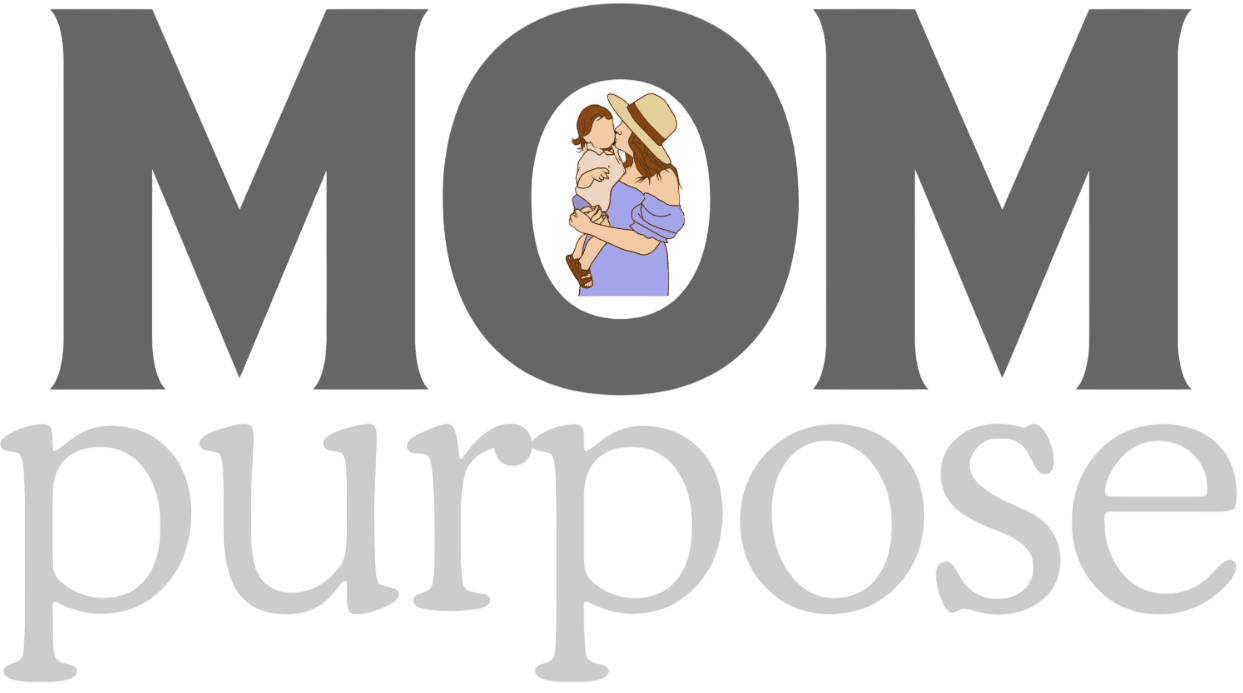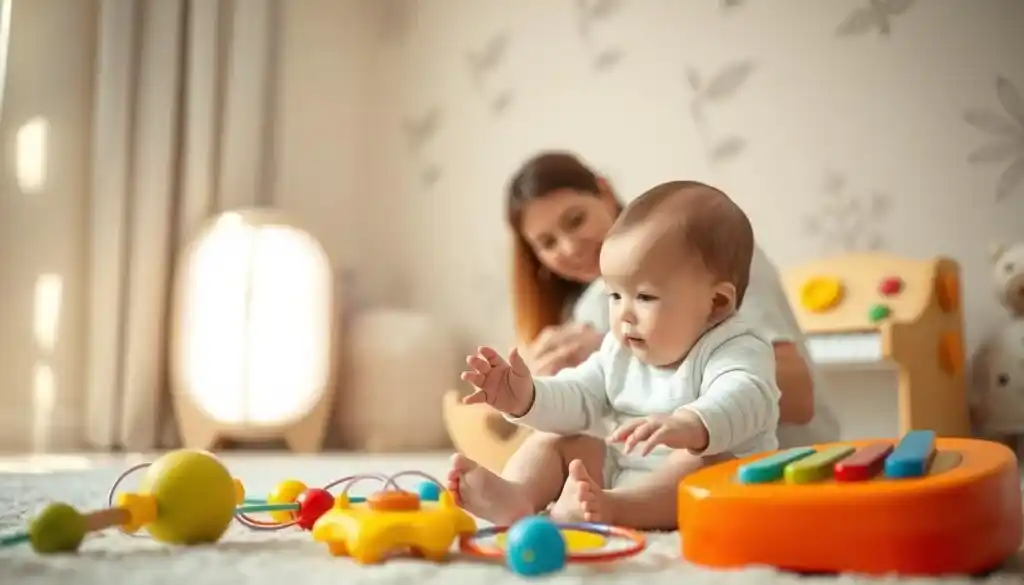Music is key in helping infants grow and learn. Choosing the right instruments can open up new learning paths. I’ve found that wooden and interactive instruments are great for young minds.
Music helps babies learn and feel in new ways. It boosts their thinking, senses, and emotions. The right instruments make playtime a chance to learn and be creative.
In this guide, I’ll show you the best instruments for babies. From simple rattles to advanced tools, these help spark your child’s imagination and support their growth.
Key Takeaways for infant music instruments
- Music instruments enhance cognitive development in infants
- Wooden instruments provide safe, tactile learning experiences
- Early musical exposure supports brain development
- Interactive instruments promote sensory exploration
- Musical play builds foundational learning skills
- Age-appropriate instruments maximize developmental benefits
Why Early Musical Education Matters for Infant Development
Music can spark amazing growth in babies. From the start, Infant Music Instruments 0-3 months are key. They help young minds grow and lay the groundwork for learning.
Music experiences are vital for infants’ early years. Parents who use music early can unlock their child’s full potential. This boosts their thinking and feelings.
The Impact on Cognitive Development
Musical interactions spark big brain connections in infants. Studies show that even Infant Music Instruments 6 months and younger can:
- Enhance neural pathway formation
- Improve memory capabilities
- Stimulate pattern recognition skills
- Boost spatial-temporal reasoning
Building Neural Pathways Through Music
Music is a powerful tool for brain development. When babies play with musical instruments, they build complex brain networks. These networks help with learning and solving problems later on.
Social and Emotional Benefits
Musical experiences do more than just help with thinking. They also boost emotional smarts, communication, and social skills. Rhythmic play teaches timing, cause-and-effect, and non-verbal talking.
Adding music to early childhood is a fun way to support growth. It helps in many areas of development.
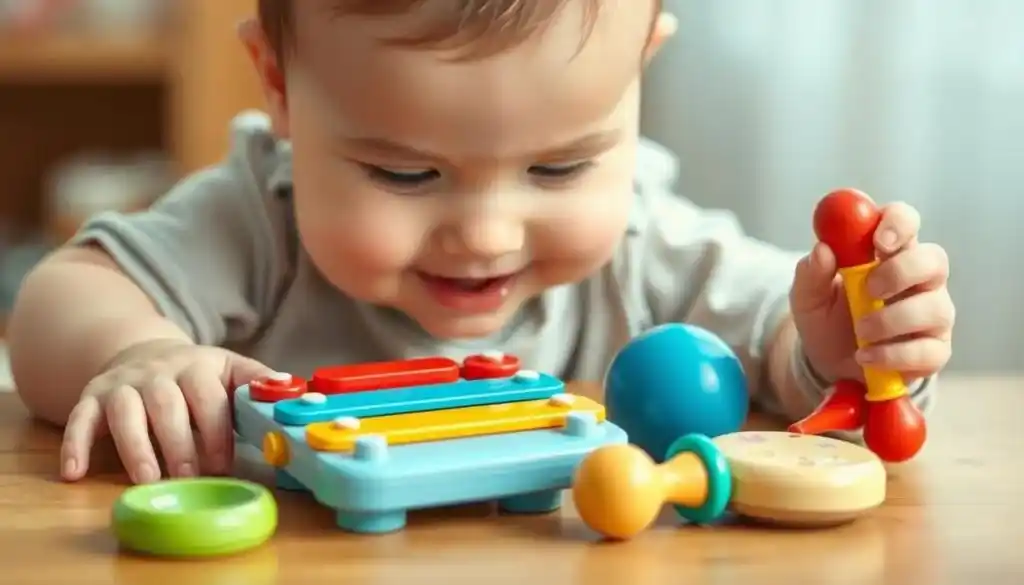
Choosing Safe and Age-Appropriate Infant Music Instruments
Choosing the right Infant Music Instruments set is important. I know it’s key to find instruments that are fun and safe. The best ones for a 1-year-old should make them curious and keep them safe.
When looking at baby musical instrument sets, keep safety in mind. Here are some important factors:
- Non-toxic materials that are safe for curious mouths
- Smooth, rounded edges to prevent potential injuries
- Appropriate size for small hands
- Durable construction that can withstand enthusiastic play
It’s also important to choose instruments that are right for a 1-year-old’s age. For this age, simple instruments that encourage exploration are best. Lightweight shakers, soft drums, and colorful bells are great. They help with sensory skills and hand-eye coordination.
When picking out an Infant Music Instruments set, consider these things:
- Ensuring no small detachable parts
- Checking for sturdy manufacturing
- Selecting instruments with gentle sound levels
- Choosing materials that are easy to clean
Always watch your baby during musical play. The right instruments can make learning fun and safe. They help your child grow and develop.
Best Wooden Baby Maracas and Shakers for Sensory Play
Exploring Infant Music Instruments montessori is a great way for parents to help their child’s senses grow. Wooden maracas and shakers make learning fun by introducing music and early learning for babies.
Sensory play is key for growing infants. Montessori musical instruments for 1 year olds help kids learn about sound, rhythm, and moving through music.
Features to Look for in Baby Maracas
- Smooth, rounded wooden edges
- Lightweight design for easy handling
- Gentle, soft sound production
- Non-toxic natural materials
Top Montessori-Approved Designs
When picking out Infant Music Instruments, look for designs that spark curiosity. Wooden maracas with different textures and sounds can keep a baby’s interest and help their brain grow.
Safety Considerations for Shakers
- Check for secure construction
- Ensure no small detachable parts
- Verify age-appropriate sizing
- Inspect for potential sharp edges
Choosing the right Montessori musical instruments for 1 year olds can make playtime educational. Wooden maracas mix sensory fun with musical learning for young kids.
Baby Drums and Percussion Instruments for Rhythm Development
Introducing music to babies can start a wonderful musical journey. Drums and percussion tools are great for helping them learn rhythm and motor skills. I’ve found that these instruments are both fun and educational for 1-year-olds.
Choosing the right percussion instruments for your baby is important. Look for safe, age-appropriate drums that help with brain development and sensory experiences. These tools engage babies’ senses, encouraging them to explore sound, texture, and movement.
- Soft hand drums with padded surfaces
- Toddler-friendly rhythm shakers
- Small tambourines with rounded edges
- Wooden percussion blocks
Start with simple, lightweight instruments when introducing music to babies. Colorful drums with soft surfaces are best. Choose instruments made from non-toxic materials that can handle baby’s play. This way, you create a safe and fun musical experience that supports learning.
Rhythm exploration is an exciting adventure for babies. By adding musical instruments to playtime, parents help children develop coordination, listening skills, and a love for music that can last a lifetime.
Montessori Musical Bells and Chimes for Auditory Learning
Exploring sound through musical instruments is a magical journey for babies. Montessori musical instruments for 1 year olds offer a special way to learn through sound. These tools help babies connect with music in a fun, interactive way.
The Montessori approach to baby musical instruments focuses on rich sensory experiences. Bells and chimes are very interesting for young ones. They make soft sounds that grab their attention and spark their curiosity.
Different Types of Bells for Various Ages
- Soft metal bells with smooth handles
- Wooden bell sets with varied tones
- Colorful handheld chimes
- Gentle wind chimes for passive listening
How to Introduce Bells to Your Baby
Begin by picking bells that are safe and easy for your baby to hold. Let them play with the instrument on their own, helping them if they need it. Make sure they have a quiet place to try out different sounds and movements.
Benefits of Bell-Based Activities
Playing with bells has many benefits for your baby:
- It improves their ability to hear sounds
- Helps develop their fine motor skills
- Boosts their sense of touch
- Improves hand-eye coordination
By adding these musical instruments to playtime, you help your baby learn naturally. You also create happy, lasting memories together.
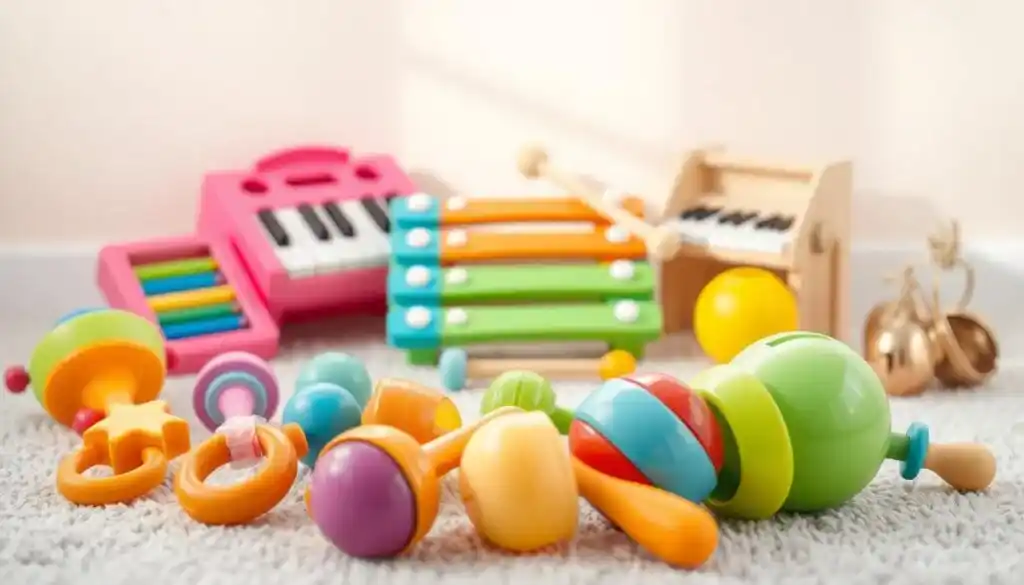
Infant Music Instruments for Different Age Groups
Musical exploration starts early in a child’s life. I’ve found that baby musical instruments fit different developmental stages. This makes learning fun for infants.
For babies around 6 months old, instruments like soft rattles and lightweight shakers are great. They help with sensory development.
- Soft rattles with gentle sounds
- Lightweight shakers
- Colorful percussion toys
When babies turn 1 year old, instruments become more interactive. Toddlers have better motor skills and are curious about making sounds. Instruments for them include:
- Small handheld drums
- Simple xylophones
- Basic keyboard toys
- Musical egg shakers
Different age groups enjoy music in their own way. Younger infants make sounds by moving randomly. Older babies start making music on purpose. Choosing the right instruments helps with learning and motor skills.
Every child grows at their own pace. Watch how your baby reacts to new music. This helps you pick the best instruments for them.
Conclusion
Exploring infant music instruments opens a world of learning for young ones. From wooden maracas to delicate Montessori bells, each instrument is a doorway to new experiences. A well-chosen baby musical instrument set can make learning fun, helping grow their minds and feelings.
Music is more than just fun for babies. These instruments help them learn and grow in many ways. By using the right musical tools, parents can help their kids learn rhythm, fine motor skills, and how to listen.
When picking out instruments for babies, safety is key. Look for ones made from safe, non-toxic materials. They should be designed for little hands and safe to play with under adult supervision. The aim is to spark a love for music, not to make them experts.
Every time a baby plays with music, they learn something new. Whether it’s tapping a drum or shaking a maraca, they explore the world through sound and touch. These moments are precious, helping your child grow and learn for years to come.
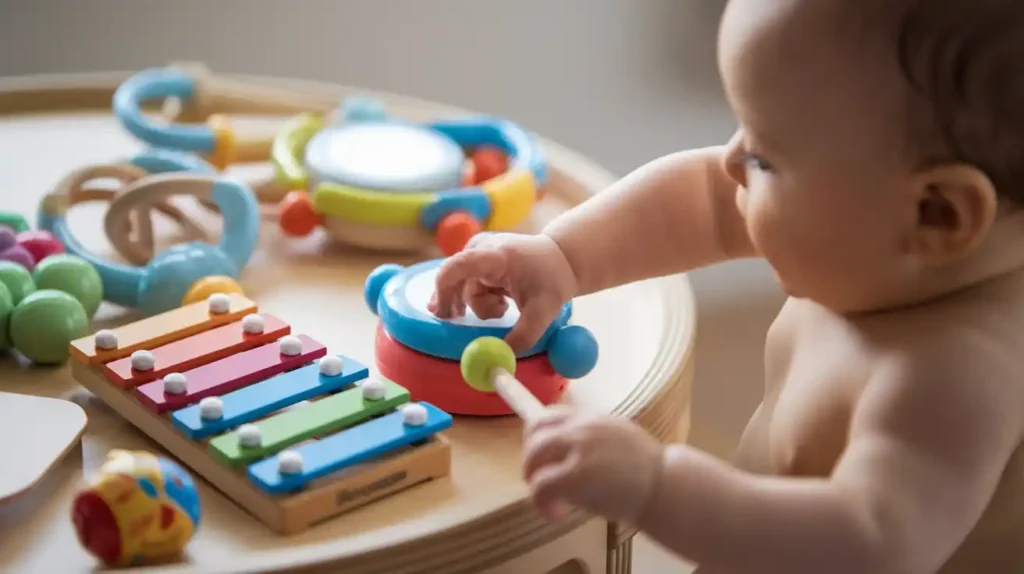
FAQ – Infant Music Instruments
At what age can I start introducing musical instruments to my baby?
You can introduce simple musical instruments to your baby from 0-3 months. Soft rattles, gentle shakers, and soft bells are great for newborns. Around 6 months, you can introduce more interactive instruments like wooden maracas or small hand drums. These encourage sensory exploration and motor skill development.
Are Montessori musical instruments better for my baby’s development?
Montessori musical instruments support self-directed learning and sensory exploration. They are made of natural materials like wood and have simple designs. These instruments help develop fine motor skills, auditory discrimination, and independent play, making them a great choice for early childhood development.
What should I look for when buying musical instruments for my baby?
When buying musical instruments for your baby, look for safety, age-appropriateness, and quality. Choose non-toxic materials and rounded edges. Also, consider size, weight, sound level, and durability. Wooden instruments from reputable brands are often a safe and sensory-rich choice.
How do musical instruments support my baby’s cognitive development?
Musical instruments are key for cognitive development. They stimulate neural pathways, enhance brain connectivity, and improve sensory processing. They help develop hand-eye coordination, rhythm recognition, and auditory discrimination. Regular exposure can also boost memory, concentration, and early math skills.
Yes, musical experiences are vital for emotional and social development. Playing instruments helps babies express emotions and develop communication skills. Group music activities enhance social interaction, turn-taking, and bonding with others.
What are some recommended musical instruments for a 1-year-old?
For 1-year-olds, consider small hand drums, xylophones with large keys, soft maracas, simple tambourines, and percussion sets. Choose lightweight, smooth-edged instruments that produce gentle sounds. Montessori-inspired wooden instruments are also excellent choices at this age.
How often should I introduce musical activities to my baby?
Try to include musical activities in your daily routine, even for just a few minutes. Short, engaging sessions of 5-15 minutes are best for babies. You can play music during playtime, before naps, or as part of bonding activities. Keep it fun, interactive, and responsive to your baby’s interest and energy.
What are the musical instruments for babies’ development?
Musical instruments like rattles, shakers, drums, and xylophones support babies’ cognitive and sensory development. These instruments help babies enhance their motor skills, pattern recognition, and auditory processing. Safe, age-appropriate instruments encourage early learning through play.
What is the first instrument for babies?
The first instruments for babies are usually simple, sensory-friendly toys like rattles, soft maracas, or cloth drums. These instruments are easy to grip, make gentle sounds, and help babies develop hand-eye coordination, listening skills, and early rhythm sense.
What is the best instrument for a 1-year-old?
The best instruments for a 1-year-old are interactive and safe items that encourage exploration, such as small drums, handheld shakers, and basic xylophones. These instruments help develop fine motor skills, rhythm, and auditory awareness while being easy for little hands to hold and play.
Can 1-year-olds play instruments?
Yes, 1-year-olds can play instruments designed for their age. They are developing motor skills and can start exploring sound through simple percussion instruments like tambourines, xylophones, and rattles. These early musical experiences help foster cognitive development, rhythm, and sensory exploration.
